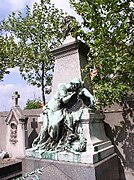Henry Charles Litolff
Henry Charles Litolff

(5 February 1818[1] – 5 or 6 August 1891/영국)
a piano virtuoso, composer of Romantic music and music publisher. He became a prolific composer,
although he is now known mainly as the founder of the Litolff Edition of classical and modern music.
Piano Trio In D Minor Op. 47
I. Allegro - The cello plays a plaintive melody to open the work. The violin takes up the melody, and after the piano plays a short lead-in, the actual first theme of the movement is heard. It is a dramatic theme that Litolff develops until the second theme is heard. The second theme is in contrast to the first as it is more lyric, but it continues a feeling of tension. The first theme returns to round out the exposition. There is a slight pause before the development begins. The first theme is heard in the solo cello, and then the piano takes it up for a short time. Litolff then shifts gears and uses the first theme for a fugue. The second theme appears as an episode in the fugue, and then the second theme gets a full hearing and is developed. The recapitulation has the first theme go through a transition that leads to the repeat of the second theme in D major. The first theme is played in the major, then a short pause before the piano begins the coda and the piece ends with a D major chord, at least in the recording linked at the end of this article. The score itself has this chord as D minor.
Litolff was born in London, the son of a Scottish mother and an Alsatian father. His father was a violinist who had been taken to London as a prisoner after being captured while fighting for Napoléon
in the Peninsular War.
He began his musical education under his father, but in 1830, when he was twelve he played for the renowned virtuoso pianist Ignaz Moscheles, who was so impressed that he gave him free lessons starting that same year. Litolff began to give concerts when he was fourteen. His lessons with Moscheles continued until Litolff eloped in 1835, at the age of 17, to Gretna Green, to marry 16-year-old Elisabeth Etherington. The couple moved to Melun, and then to Paris.
He separated from Elisabeth in 1839 and moved to Brussels,[2] and around 1841 moved to Warsaw where he is believed to have conducted the Teatr Narodowy (National Theatre) orchestra.
In 1844 he travelled to Germany, gave concerts and taught the future pianist-conductor Hans von Bülow.[3] The following year, he returned to England with the idea of finally divorcing Elisabeth;
but the plan backfired and he ended up not only heavily fined but imprisoned. He managed to escape and flee to the Netherlands.[n 1] He became friends with music publisher Gottfried Meyer and, after Meyer's death, married his widow Julie in 1851 (after finally being granted a divorce from Elisabeth as a new citizen of Brunswick). This second marriage lasted until 1858, when he divorced her and once again moved to Paris. He died at Bois-Colombes near Paris.
Works
His most notable works were the five concertos symphoniques, essentially symphonies with piano obbligato. The first one, in D minor, is lost; the others (which, though not regularly heard in the concert repertoire, are all available in modern recordings) are:
- Concerto Symphonique No. 2 in B minor, Op. 22 (1844)
- Concerto Symphonique No. 3 in E-flat major, Op. 45 (c. 1846)
- Concerto Symphonique No. 4 in D minor, Op. 102 (c. 1852)
- Concerto Symphonique No. 5 in C minor, Op. 123 (c. 1867)
The only one of Litolff's compositions still performed at all regularly is the somewhat Mendelssohnian scherzo from the Fourth Concerto Symphonique, although his music was admired by Franz Liszt and he was the dedicatee of Liszt's own First Piano Concerto.
Litolff's Drame symphonique No. 1 Maximilien Robespierre, Op. 55, was one of the works conducted on Christmas Eve 1925 by Yuri Fayer at the Bolshoi Theatre in Moscow to accompany the world's first showing of Sergei Eisenstein's film Battleship Potemkin.[4]
Gallery
'♣ 음악 감상실 ♣ > (피아노 3중주)' 카테고리의 다른 글
| Shostakovich: Piano trio No. 1, op. 8, in C minor (1923) (0) | 2015.09.04 |
|---|---|
| Johannes Brahms - Piano Trio In A Major Op. Posth. (0) | 2015.09.03 |
| Tchaikovsky - Piano Trio in A minor, Op. 50 (0) | 2015.07.02 |
| Carl Czerny - Piano Trios Nos 2번, 4번 (0) | 2015.06.07 |
| Schubert - Piano Trio "Sonate" D28 in B Flat Major (0) | 2015.06.03 |

